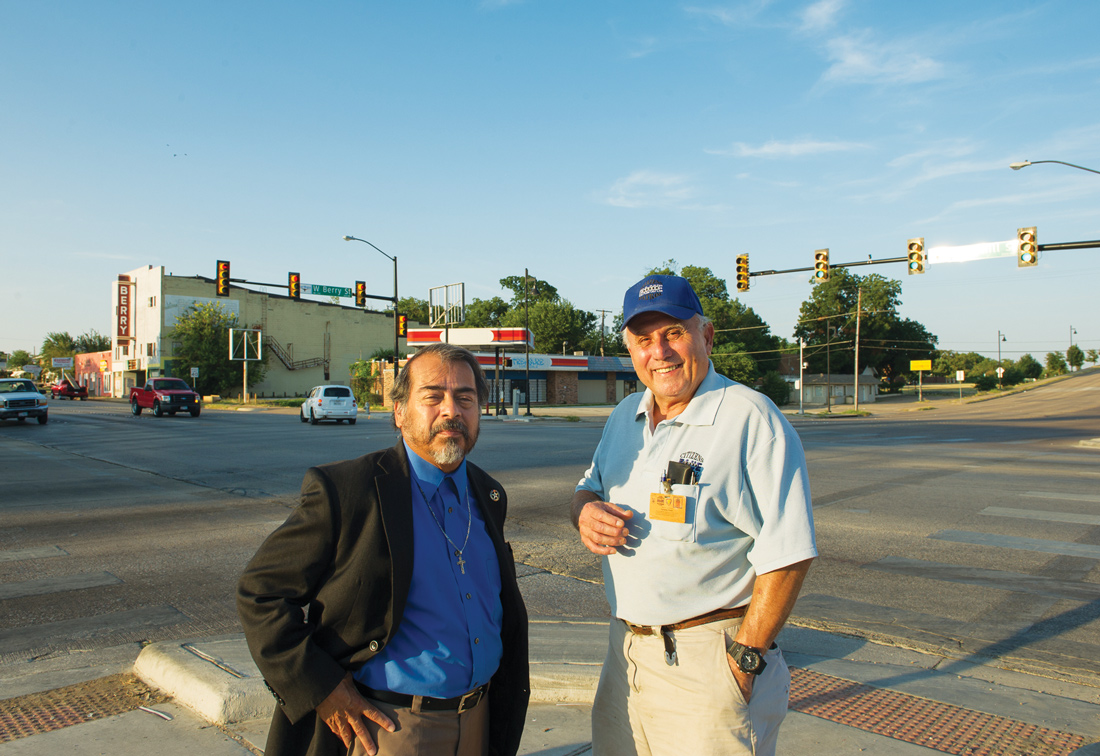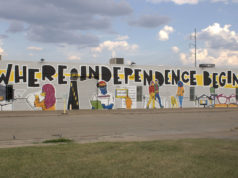One of Fort Worth’s best spots to grab a late-night street taco or catch a local punk band has long been Hemphill Street. The road isn’t just a local treasure. It’s an important thoroughfare between downtown and South Fort Worth.
It’s also in desperate need of attention. Despite the heavy flow of traffic, the intersection of Hemphill and Berry streets appears far from inviting. Half the storefronts are shuttered.
But brighter possibilities lie nearby. Just a few miles north, shiny bike-sharing stands and bistros draw thousands to West Magnolia Avenue, and just a few miles farther north, the West 7th Street corridor is booming.
And just like those two areas, the Hemphill/Berry intersection has been designated as an urban village, meaning that the city acknowledges the area’s importance to Fort Worth’s growth.
Next month, the city will begin giving the intersection a much-needed facelift. But several community leaders said the help is, while appreciated, long overdue.
For the project, approved last month by city council, the city will spend $916,853.85 on “new sidewalks, curbs … pedestrian lights … landscaping,” and other improvements.
City councilperson Ann Zadeh said in an e-mail that the improvements are intended to create a “safer, more comfortable, and appealing pedestrian environment. This first streetscape project in the urban village will contribute to a more walkable urban village […] and encourage redevelopment and revitalization” in the area.
Christopher Bonilla knows this part of town. Owner of The Bonilla Group, a land development consulting company, he grew up nearby and is a voting member of the Hemphill Corridor Task Force, a development advisory group with which the city regularly consults.
“That’s exactly what the project is going to be,” he said, “a touchup.”
As someone whose parents still live in the neighborhood, he’s grateful for the help and agrees with the city’s vision to make the area more pedestrian friendly. But touchups go only so far.
“We need more than curb appeal,” he said. “We need businesses to go along with it.”
Groups like Hemphill’s task force, he said, need to show stronger leadership in coordinating efforts between city and private businesses and developers. In addition to inadequate city funds, he said, local neighborhood associations have placed too many restrictions on the types of businesses that are welcomed.
“Unless it’s a Starbucks, [neighborhood association representatives] flat don’t want it,” he said.
Urban village guidelines like those for Hemphill/Berry, he said, often add structural requirements that are too restrictive. As an example, he cited a two-story Taco Bell at the intersection of Berry and 8th streets that has an unoccupied second-story office. The fast food company was required to include the space.
But Zadeh said property owners and developers are more likely to “invest in the enhanced urban design features required by [the] urban village plan if they expect others in the urban village to be held to the same standards.”
Higher building standards, she said, are more likely to lure private investment in urban villages.
David Cantu-Crouch, chairman of Hemphill’s task force, echoed Bonilla’s thoughts on the pace of progress in the area, but he didn’t see neighborhood associations as part of the cause of slowness.
“To be honest,” he said. “The [progress] on this [city] project has lingered. You would have to speak to the city of Fort Worth as to why. Hemphill is a really great street that has a lot of good things going for it. We need to work with the city [to improve communication] and ensure zoning and code issues are enforced in a timely manner.”
And, he added, the city needs to make ongoing improvements to the street’s infrastructure.
Fernando Florez, vice president of the South Hemphill Heights Neighborhood Association who co-founded the Hemphill Corridor Task Force in 1993, has been advocating for public funds to revitalize the area for more than two decades. He’s elated to see the street improvements finally come.
“The next battle we fought was to create an urban village, against some opposition, at the intersection of Hemphill/Berry,” he said, which brought along a neighborhood empowerment zone, opening the door to special programs like affordable housing and social services.
The victory “has helped both our residential and commercial areas,” he said. “So you see, this has been a long time coming. I am now the old man in all of this, and my goal is to mentor others so that projects such as this one can continue moving forward.”
Florez and community leaders plan to use the streetscape improvements to leverage the city to repair parts of the road around the intersection and entice investors.
Encouraging investment from local and outside developers is at the heart of the goal of the urban village, Zadeh said.
“These streetscape improvements are intended to encourage existing property owners to invest in their properties,” she said. “However, it often takes time for these changes to occur, because the real estate market has to respond to the incentives. Even in the Magnolia urban village, it took a significant amount of time before the original streetscape improvements on [the avenue] inspired a real estate market turnaround that led to the many new developments we see in that urban village today.”
Florez has found that city movers and shakers don’t always move as fast as he’d like them to on projects like this.
“I know how the game is played,” he said. “It will be up to us to push things [to] determine our future. No one will hand us anything. We have to fight for it.”
Cindy Vasquez, spokesperson for the city manager’s office, said construction is tentatively scheduled to begin sometime in August. The project, she said, will happen in one phase. No additional improvements are planned.
Bonilla knows revitalization is an uphill battle, and there are no guarantees. But he worries that that hill is steeper in areas that don’t fit the city’s picture of how Fort Worth should look.
“We have a certain income level here, and, once again, we don’t look like the typical West 7th Street person,” he said. “Berry/Hemphill is not in the arena area, and it’s not the Cultural District. Those areas have political clout with the folks downtown.”













Mr. Bonilla is wrong. He will advocate for any type of business. His only interest in Hemphill Street is financial and his criticism of the neighborhoods. It’s the fault of individuals like Bonilla that Hemphill is such a mess. The man has no credibility.
On the bright side there is David Cantu; he genuinely cares.
“We have a certain income level here…..:” Wrong. South Hemphill Heights is one of the last organic mixed-income neighborhoods in this city, to say nothing of Ryan Place.
“Berry/Hemphill is not in the arena area, and it’s not the Cultural District.”
True. The HCTF should market Hemphill/Berry as the bookend intersection to the Berry/University urban village – like a front gate to the TCU area.
what an idiot.
I wouldn’t go that far. I’m just tired of people assuming everyone living around Hemphill/Berry is poor.
I was one of the people who tried to fight off Walmart from coming into the urban village, as it didn’t meet the mixed use criteria and is just a big box store. But the city allowed it anyway. The urban village is a good idea, but will the streetscape work act as a catalyst to bringing in mixed use development? We’ll have to wait and see. The Walmart pretty much took up the entire southeast corner!
The vacant gas station and the old Berry Theater are (over) ripe for development. Maybe O’Reilly could be bought out and divided into smaller parcels.
“There you go again”…
When it comes to public money – to those receiving it, it is never enough. I’m always amazed by the people that gripe but typically they aren’t willing to find a way to put their own money where their mouth is. Kudos to the city for taking an important step to BEGIN revitalization. It has to start somewhere – and chances are you’ll get their faster if you quit complaining about the journey.
You need to be talking this cheap crap to the high-rolling greed-heads over on 7th St. and the museum district and the Trinity River downtown jillionaires. What’s wrong with you? Did your Mama have any brats with a lick of sense? What the hell? Decent citizens should be throwing rocks at your stupidity. Good grief, man. Tax money streams in for the high-rolling, self-entitled, dip-sticks. Again, no one is this stupid. The johnson grass along the railroad line here in the Southside going east from McCart is over 11 feet high at the worse & 7 feet on the low height. You can fall out of sight in the holes in the neighborhood streets. The street light in the middle of my block has not burned in 7 weeks. It takes a army tank to go down the alley. There are tons of public money for black-hearted, greed-head, high-rollers to get a 6 million dollar bridge on 7th St. over the Trinity and working class people need to put up their own money to get a lousy street light to shine. My bird-dog is way smarter than everyone on your street put together. Let me take a wild guess…I’m thinking you’re a stinking, Tea-Bagging, Repug. Did I hit the target? You’re on my prayer list Bubba. You’re disgraceful, you got to be a Tea-Bagger nit-wit like our governor and mayor. You kin to Rick Perry?
stranger, heed well what I say,PARAJUMPERS NAISET UNTUVATAKKI, that as soon as may be thou mayest gain at my father’s hands an escort and a safe return. Thou shalt find a fair grove of Athene,DUVETICA MIEHET UNTUVALIIVI, a poplar grove near the road, and a spring wells forth therein,http://www.indus
Benny is correct about what he said. Just think about all the tax abatement money that was paid to Radio Shack-Tandy with all those promises about jobs etc and they filed for bankruptcy and shut down most of their retail outlets. You know why? Because you cannot sell a 110V electrical outlet for $10.00 and compete with an 18 wheeler full of electronics smuggled into the US from Mexico and sold at your local flea market for 50 cents or a dollar. If you’re competing with organized crime (many are aligned with politicians in this city) you’re going to lose.
While the HCTF vision is great and wonderful and any progress at rebuilding the infrastructure is wonderful, the residential sector is the ultimate arbiter of a successful mission. In this case it’s going to fail. Why? Use it or lose it. I spoke with a resident at the corner of Cantey and May Street who are selling a house for 100K. The gentleman told me it was converted at one time to a duplex but that he remodeled it and turned it back into a single-family residence. This conversation was difficult in Spanish because they he nor the woman could utter one single syllable in English. Finding someone in Texas 70 or eighty years old who cannot speak English is a bad thing. Because barriers are created and extend across multiple social and economic fronts. This is like finding a disconnected tribe of natives in the Amazon jungle with a new language and culture. Great for an Anthropologist but bad for a legitimate shoe salesman in Texas.